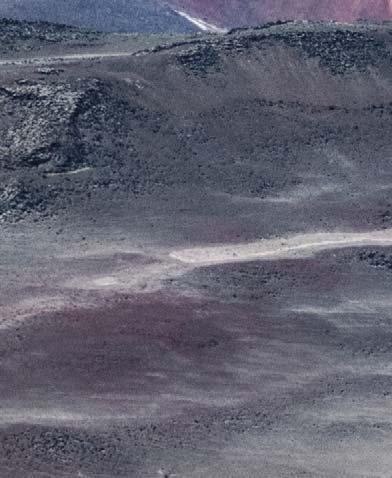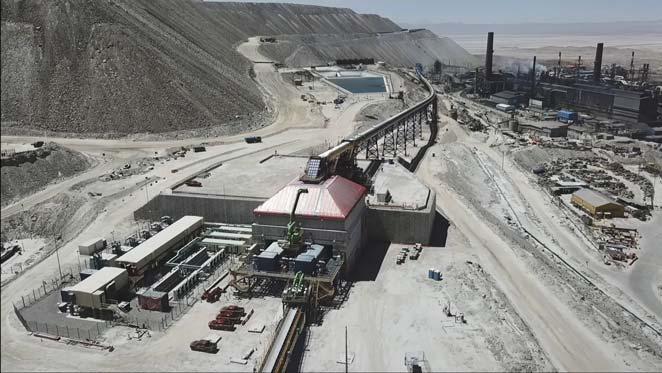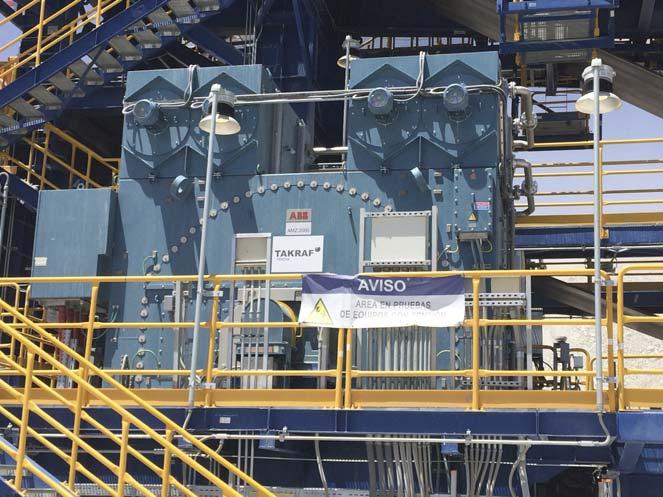
10 minute read
Driving The World’s Largest Opencast Copper Mine












Ulf Richter, ABB, Germany, outlines how gearless conveyor drives are powering the world’s largest opencast copper mine in Chile.

Gearless conveyor drives (GCDs) are now the preferred solution in many mining projects, particularly those that require high drive power, helping to boost the eff iciency of higher-capacity belt systems for greater ore throughput and reduced energy usage, equipment downtime, and maintenance costs.
In the high-power regime, conventional conveyor drives face multiple challenges, mostly associated with the gearbox. Building a gearbox that can handle power levels above 3.5 MW is a complex process; once in operation they are maintenance intensive and their productive lifetime is relatively short.
A GCD, in contrast, uses a large, low-speed synchronous electric motor driving directly onto the pulley shaft designed to handle the high torque produced by such motors. The motor is controlled by a variable-speed drive to produce a shaft rotational speed typically in the range of 50 – 70 rpm. There are usually several drive modules in a drive station and there can be multiple drive stations on the conveyor.
Existing GCDs vary from 2.5 – 7 MW, with a total connected power of 5 – 20 MW. GCDs are also robust, require minimal maintenance, and can boost the energy eff iciency of high-power systems by 3 – 8%.
GCDs developed by ABB off er mining operators these benefits and are currently being implemented at one of the most challenging mining projects of all time: the Chuquicamata mine in Chile.

Resetting the parameters for power and control
In September 2020, 2850 m above sea level in the high desert of the Antofagasta region in northern Chile, the world’s most powerful belt conveyor system, 13 km long, was brought online, connecting underground operations at the Codelco-owned opencast copper mine directly to the concentrator.
Two 20 MW TAKRAF conveyors each lift 11 000 tph of ore more than 600 m to reach the surface of the underground mine. The total lift is approximately 1.3 km and then the ore is fed to a 15 MW overland conveyor.
GCDs were the only economically feasible way to provide enough power to run the 20 MW conveyors. The limit for an input pinion gearbox on a conveyor is 3 – 4 MW, so the belt system at Chuquicamata would have either required eight motors driving into a gearbox with an output shaft , or multiple conveyors with lower power ratings and multiple


transfer stations. Either scenario would require substantially more materials, space, and infrastructure to deliver the requisite power. GCDs were therefore the simplest way to achieve the production output that the customer wanted, with the added benefit of reduced maintenance and significant eff iciency gains.
ABB, in partnership with TAKRAF, successfully commissioned the most powerful GCD system in the world, comprising a total of 11 drives with synchronous motors running at low speeds of 50 – 60 rpm, and with a rated power of 5 MW each, resulting in a motor shaft torque of roughly 900 000 Nm. The total installed drive power for the entire system, including multiple feeder conveyors, is 58 MW.
Volume control: reducing carbon dioxide and noise emissions
At Chuquicamata, switching from opencast with truck/shovel operations to underground operations, using the TAKRAF conveyor with ABB gearless drives, will help mine owner Codelco save roughly 130 million l/y of gasoline by eliminating the need for 120 large-haul trucks, bringing the mine's carbon dioxide emissions down from 340 000 tpy to 100 000 tpy – a saving of approximately 66%.
In Europe, meanwhile, ABB is partnering with a mine in the Czech Republic to reduce emissions of a diff erent kind. By upgrading shaft mounted geared drives on an existing conveyor system with GCDs, powered by synchronous permanent magnet motors, the mine owner is able to meet stringent EU noise emission limits, as well as prevent frequent motor bearing failures due to vibration issues.
Drives containing gearboxes with multiple moving parts, turning at 1000 rpm or higher, can be very loud, and thus run the risk of exceeding the EU noise emissions limit of 85 dB(A) (A-weighted decibels).
Using GCDs at approximately 50 rpm, ABB restricts noise emissions from the drive unit to less than 75 dBA, providing the mine with all the benefits of gearless drives, while negating the need for noise encapsulation (housing around the whole geared drive unit) or noise protection walls along the conveyor system.

Figure 1. The Chuquicamata mine in the high desert of Northern Chile.

Figure 2. ABB's GCDs are the power behind the worlds largest opencast copper mine.

Figure 3. ABB GCDs are robust, require minimal maintenance, and can boost the energy eff iciency of high-power systems by 2 – 3%.
Energy effi ciency and monitoring
Unlike conventional drive pulleys with gears and motors, the 5 MW motors at Chuquicamata are directly coupled to the drive pulley and employed in the conveyor systems with four 5 MW motors, a total of 20 MW.
The GCD solution is highly integrated as part of the drive pulley. A single bearing solution for the motor with a special membrane coupling was designed and patented by TAKRAF.
ABB’s Mining Conveyor Control Program is a soft ware package developed by ABB for conveyor drives control. It has been designed to run directly on the control board of its medium voltage (MV) or low voltage (LV) variable-speed drives. The soft ware is specifically configured for conveyor applications, allowing for the setting, by parameter, of the essential conveyor drives' control functions. Used at Chuquicamata, it ensures smooth belt operation and safe synchronisation between high-power motors and high-power hydraulic brakes, necessary for secure operation of steep uphill conveyors – the GCD technology meets the high demands of the massive conveyor system for accurate starting with no roll-back and precise load-sharing control.
ABB liquid-cooled MV voltage-source frequency converters, together with the large synchronous motors, deliver a decrease in active and reactive power consumption for high energy eff iciency.
A system that transports cooling liquid several kilometres out of the tunnel was installed to manage significant heat losses from the motors – in excess of 1 MW – in the subterranean environment.
The ABB/TAKRAF solution at Chuquicamata is connected to the ABB AbilityTM System 800xA distributed control system for eff icient data acquisition, equipment assessment and process optimisation, including condition monitoring of the pulley bearings. System 800xA monitors and collects data from multiple sensors embedded in the motor drive system, monitoring for failures and identifying maintenance needs.
Overcoming logistical challenges at Chuquicamata
The Chuquicamata project also constituted a major logistical undertaking. With 50% of the conveyor system located underground, installing large equipment – such as five containerised e-rooms housing the drive station and electrification, control, and instrumentation equipment – was a major challenge, particularly in the remote, dry, and dusty conditions that typify the high desert in northern Chile.
ABB synchronous motors are factory assembled and tested as complete units, including the base frame, before being shipped and installed in one piece. A novel embedding concept jointly developed by TAKRAF and ABB enabled the GCD motors to be installed and aligned in a single day, a major benefit compared with existing cantilevered GCD solutions that can take 2 days or more to install.
The motors can also be mechanically disconnected from the drive pulley quickly, so that operations can continue if drive failure occurs. The motor air gap is fully under control and can be re-adjusted easily.
In total, commissioning of the drives at the Chuquicamata mine took just 14 days, a new record. The underground project is expected to extend operations at Chuquicamata for the next 40 years.
In addition, ABB provided an installation supervisor and 100% perfect documentation of the whole drive system so that a third-party company could install it without support, as per customer requirements.
Breathe easy with ventilation on demand
ABB has also installed its ventilation on demand (VoD) solution, ABB Ability Ventilation Optimizer, at Chuquicamata to provide clean air to workers in line with the strict health, safety, and environmental requirements.
Ventilation systems can account for 50% of energy use in underground mines, yet production may only be concentrated in 20% of a facility at any one time. By distributing clean air only where and when people or machines are working, Ventilation Optimizer streamlines ventilation systems and reduces energy costs, while at the same time ensuring a safe working environment for personnel.
It does this by employing sensors throughout the mine that transmit real-time information regarding air quality, diesel vehicle usage, and personnel to an ABB Ability System 800xA operator for analysis. The Ventilation Optimizer then operates equipment according to actual ventilation demands – which are dynamically calculated from mine production schedules and events, as well as event equipment status and location.
The VoD solution has three implementation levels, the most advanced of which uses an algorithm, sensor feedback, and advanced multivariable control technology to run all ventilation fans in optimal mode, distributing the air supply more eff iciently and minimising energy consumption in real time. By controlling mine ventilation in this manner, annual energy savings of up to 50% are possible.
ABB sees Ventilation Optimizer as part of the transition on the journey towards the all-electric mines of the future, by helping to reduce nitrous oxide emissions from diesel and diesel-electric hybrid trucks.

Figure 4. High drive power helps to boost the eff iciency of higher-capacity belt systems for greater ore throughput and reduced energy usage, equipment downtime, and maintenance costs.
Forward thinking: future GCD and digital technologies
With global demand for medium power conveyors from 3 – 10 MW for use in major projects, such as Chuquicamata, set to increase, ABB has developed gearless conveyor drives for medium power to ensure mining customers continue to reduce their cost per tonne of production and stay competitive.
Meanwhile, innovations in the sphere of augmented reality now allow ABB experts to see the same view as an on-site service engineer in real time, allowing them to provide remote support, which is of value in the wake of COVID-19 travel restrictions.
ABB’s augmented reality collaboration application, ABB Ability Remote Insights, digitalises the field operator experience and vastly improves interaction between field and control room operations. Operatives will be able to access hands-free, real-time data related to plant assets, processes, or procedures using industrial tablets, smartphones and Microsoft HoloLens glasses, not only increasing real-time collaboration, but also enabling immediate data entry from the user interface in the field.
Similarly, ABB’s newer solutions use advanced data analytics, artificial intelligence (AI) tools, and machine learning to correlate and analyse signals from critical mining machinery, such as GCDs and motors. Not only does this equate to better online support from off -site experts, it has the potential to remove personnel from risky environments – all while maintaining mine production and maximising profits.
Conclusion
As at Chuquicamata, GCDs can be deployed in complex, world-class projects. They can provide multiple benefits for mine operators by helping to increase eff iciency and reduce energy usage, equipment downtime, maintenance costs, and noise. Together with the advent of augmented reality collaboration applications, advanced data analytics, AI tools and machine learning, mining companies and their technology partners are set to further increase the eff iciency of operations, however remote or challenging.










